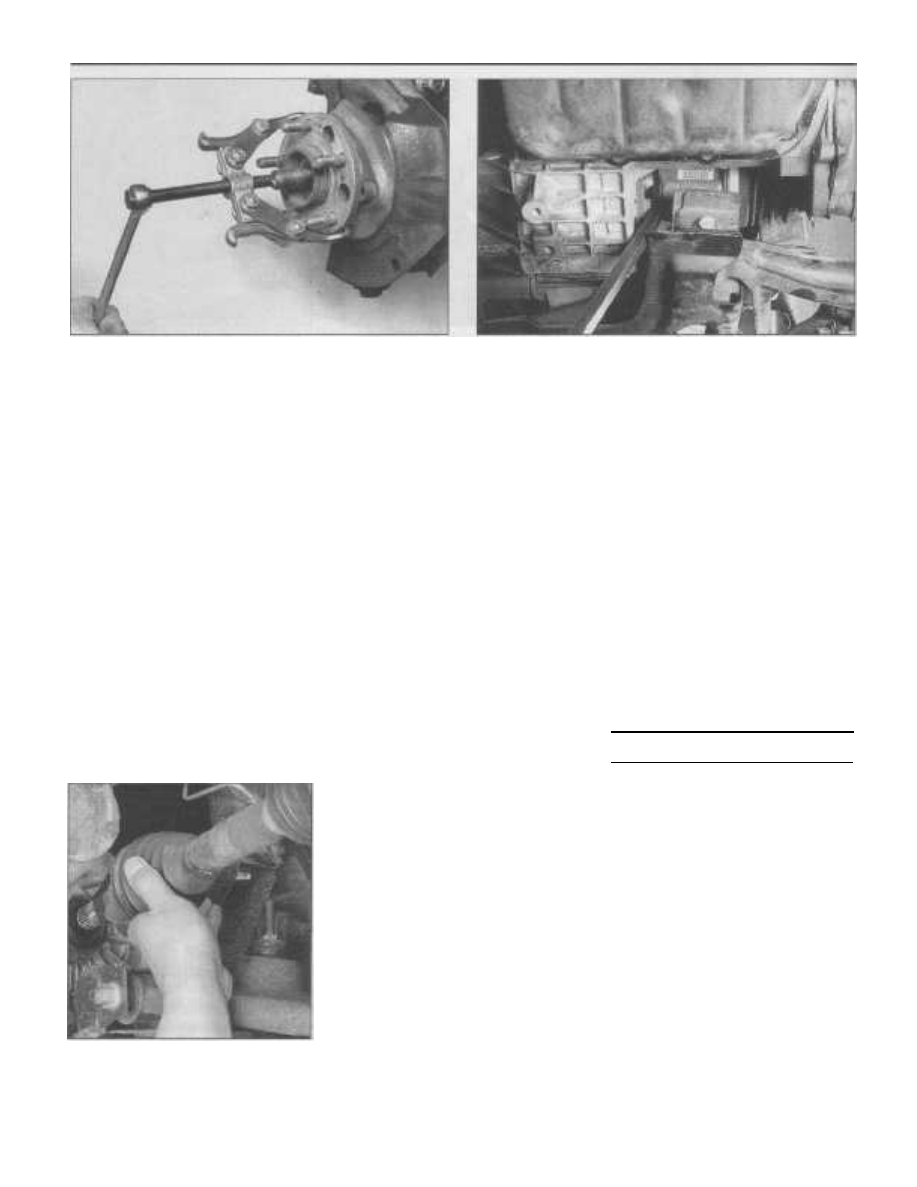Chrysler Cirrus, Dodge Stratus, Plymouth Breeze Haynes. Manual - part 26

8-6
Chapter 8 Clutch and driveaxles
8.8c If the penetrating oil and hammer technique prove
unsuccessful, use a two-jaw puller to push the driveaxle from
the wheel hub
8.10 Insert a prybar between the tripod joint housing and the
transaxle. Pry on the driveaxle until you feel the retaining circlip
on the driveaxle disengage from the differential side gear
trating oil to the hub splines, install the hub nut
on a few turns and strike the end of the
driveaxle with a soft-faced hammer to break it
loose (see illustration). DO NOT attempt to
drive the driveaxle stub out of the wheel hub
using a hammer! In some cases it may be nec-
essary to push the driveaxle stub out of the
hub using a two-jaw puller (see illustration).
9
Before you remove the driveaxle from
the transaxle, check for lubricant leakage in
the area around the driveaxle oil seal. If
there's evidence of a leak, you'll want to
replace the seal after removing the driveaxle
(see Chapter 7, Part A).
10
To remove the driveaxle from the
transaxle, position a prybar against the inner
tripod joint housing and carefully pry it out
until the retaining snap-ring on the driveaxle
is disengaged from the transaxle side gear
(see illustration).
11
While supporting the driveaxle, pull
straight out on the tripod joint housing to
avoid damaging the driveaxle seal located in
the transaxle (see illustration). Caution: Pull
on the tripod housing only! DO NOT pull on
8.11 To avoid damaging the transaxle oil
seal, support the ends of the driveaxle and
pull it straight out
the axleshaft - the only thing keeping the axle-
shaft and tripod housing together is the seal-
ing boot - pulling on the axleshaft might sepa-
rate the tripod joint and result in component
damage. Remove the driveaxle assembly
from the vehicle.
12
Should it become necessary to move
the vehicle while the driveaxle is removed,
before installing the wheel, place a large bolt
(approximately the same size as the driveaxle
splined shaft) with two large washers (one on
each side of the hub) through the hub and
tighten the nut to 180 ft-lbs. This will prevent
the hub/wheel bearing from separating when
the vehicle weight is placed on the wheel
hub/bearing assembly.
13 If you noted evidence of a leaking
driveaxle seal, refer to Chapter 7A for the seal
replacement procedure.
Installation
14 Installation is the reverse of removal, but
with the following additional points:
Thoroughly clean the driveaxle splines
and hub/bearing shield.
Clean the
respective areas around the driveaxle oil
seal and the steering knuckle/hub splines.
Install a new snap-ring on the inner
driveaxle splines.
c) Lubricate the driveaxle oil seal, tripod
joint splines and sealing surface with the
appropriate transmission lubricant (see
Chapter 1).
When installing the driveaxle into the
transaxle, hold it straight out and push it
in sharply to seat the driveaxle snap-ring
into the groove in the transaxle side
gear. To make sure the circlip is properly
seated, grasp the tripod joint housing
(not the driveaxle) and attempt to pull it
out of the transaxle by hand.
Before installing the driveaxle into the
hub/steering knuckle, lubricate the
driveaxle outer splines with a light coat
of multi-purpose grease. After installing
the driveaxle, install the driveaxle/hub
nut and tighten the nut securely but not
to the specified torque at this time.
Tighten the lower control arm balljoint
nut (see Chapter 10) and brake caliper
guide pins (see Chapter 9) to the torque
listed in the Specification Section in their
respective Chapters.
Install the wheel and lug nuts then lower
the vehicle.
On 1995 through 1999 models, tighten
the driveshaft/hub nut to the torque
listed in this Chapter's Specifications.
Install the spring washer, lock washer
and new cotter pin. Bend the ends
around the nut - not over it. On 2000
models, use a new driveshaft/hub nut
and tighten it to the torque listed in this
Chapter's Specifications.
i) Tighten the wheel lug nuts to the torque
listed in the Chapter 1 Specifications.
I)
Check and add transaxle/differential
lubricant as applicable (see Chapter 1).
9
Driveaxle boot replacement
Note 1: If the CV joints are damaged (usually
due to torn boots), individual replacement
parts are not available. The complete driveaxle.
new or rebuilt, must be replaced as an assem-
bly and are available on an exchange basis.
Note: 2: On 1995 to 1997 models, the only
serviceable part on the outer CV joint is the
hub/bearing shield which is pressed onto the
outer CV joint housing splined shaft. The
outer CV joint cannot be removed from the
axleshaft. In the event of bearing or sealing
boot failure on these models, the entire
driveaxle must be replaced.
Outer joint boot (1998 and
later models only)
Disassembly
Refer to illustrations 9.2, 9.4, 9.5a and 9.5b
1
Remove the driveaxle from the vehicle
(see Section 8).
2
Mount the driveaxle in a vise with soft
a)
b)
d)
e)
f)
g)
h)